



Volta's Battery
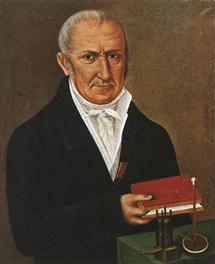 Allesandro Volta was in 1745 in Camo Italy. In 1777, when he was twenty-two, Volta was appointed Professor of Physics at the University of Pavia. It was here that he tried to duplicate a famous experiment by the scientist Galvani. In his experiment, Galvani was dissecting a frog when the frog's leg began to twitch. Volta first thought that a natural force like lightning caused this phenomenon, but his theory was disproved when he successfully reproduced the experiment on a clear, cloudless day. Volta then concluded that the twitching could be caused by the two metal pieces that were holding down the frog's leg. He observed that a current of electricity was being passed from the dissimilar metals through the moist flesh of the frog's leg. This led him to develop a device that would sustain a current of electricity, the first battery. He did this by alternatively stacking copper and zinc disks into a tower. Volta then placed pieces of paper he had soaked in salt water in-between each disk. This device became known as voltaic pile, and the French Emperor Napoleon later initiated the Volta Prize and made Volta a count for his discovery. Allesandro Volta died at age eighty-two in 1827.
Allesandro Volta was in 1745 in Camo Italy. In 1777, when he was twenty-two, Volta was appointed Professor of Physics at the University of Pavia. It was here that he tried to duplicate a famous experiment by the scientist Galvani. In his experiment, Galvani was dissecting a frog when the frog's leg began to twitch. Volta first thought that a natural force like lightning caused this phenomenon, but his theory was disproved when he successfully reproduced the experiment on a clear, cloudless day. Volta then concluded that the twitching could be caused by the two metal pieces that were holding down the frog's leg. He observed that a current of electricity was being passed from the dissimilar metals through the moist flesh of the frog's leg. This led him to develop a device that would sustain a current of electricity, the first battery. He did this by alternatively stacking copper and zinc disks into a tower. Volta then placed pieces of paper he had soaked in salt water in-between each disk. This device became known as voltaic pile, and the French Emperor Napoleon later initiated the Volta Prize and made Volta a count for his discovery. Allesandro Volta died at age eighty-two in 1827.
Picture Sources:
Battery: http://www.converter.cz/fyzici/images/volta-zdroj.jpg
Portrait: http://bullarchive.web.cern.ch/bullarchive/0013/art1/Photo1.gif
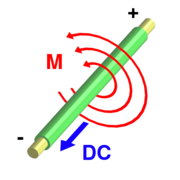
In Electromagnetism, An Electric Current Produces a Magnetic Field
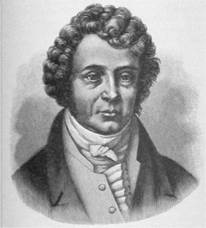 Andre Ampere was born on January 22, 1775 in Polemieux, France. From an early age Ampere had a passion for knowledge. By the age of eighteen he was an expert in history, travels, poetry, philosophy, the natural sciences, and Latin. In 1809 he was appointed professor of mathematics at the polytechnics school of Paris. It was here that he discovered the relationship between electricity and magnetism. Today it is known as the field of electromagnetism, but Ampere called it electrodynamics. In 1836, Ampere died at age sixty-one in Marseille. Ampere is credited with the discovery of electromagnetism and the standard unit of measurement of an electric current (an ampere) is named after him.
Andre Ampere was born on January 22, 1775 in Polemieux, France. From an early age Ampere had a passion for knowledge. By the age of eighteen he was an expert in history, travels, poetry, philosophy, the natural sciences, and Latin. In 1809 he was appointed professor of mathematics at the polytechnics school of Paris. It was here that he discovered the relationship between electricity and magnetism. Today it is known as the field of electromagnetism, but Ampere called it electrodynamics. In 1836, Ampere died at age sixty-one in Marseille. Ampere is credited with the discovery of electromagnetism and the standard unit of measurement of an electric current (an ampere) is named after him.
Picture Sources:
Electromagnetism: www.answers.com/topic/amp-re-s-law
Portrait: http://en.wikipedia.org/wiki/Andr%C3%A9-Marie_Amp%C3%A8re
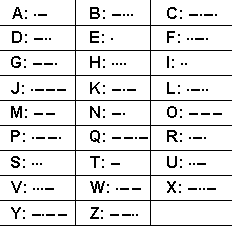
Morse Code
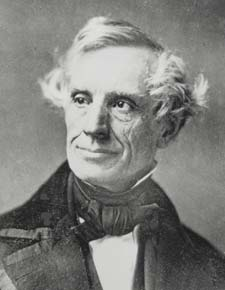 Samuel Morse was born on April 27th, 1791 in Charlestown, Massachusetts. He attended Phillips Academy as a child before studying at Yale University at age fourteen. He studied art under American painter Washington Allston. While painting, Morse enjoyed attending seminars about electricity given by Benjamin Silliman. It was from this knowledge of electricity that Morse adapted magnetism to an electromagnetic telegraphy to develop a binary code of long or short signals that represented each letter in the alphabet. Morse named this code after himself, calling it Morse code. Samuel Morse died at age eighty on April 2nd, 1872 in New York. He is credited with the invention of Morse Code, which can still be used today.
Samuel Morse was born on April 27th, 1791 in Charlestown, Massachusetts. He attended Phillips Academy as a child before studying at Yale University at age fourteen. He studied art under American painter Washington Allston. While painting, Morse enjoyed attending seminars about electricity given by Benjamin Silliman. It was from this knowledge of electricity that Morse adapted magnetism to an electromagnetic telegraphy to develop a binary code of long or short signals that represented each letter in the alphabet. Morse named this code after himself, calling it Morse code. Samuel Morse died at age eighty on April 2nd, 1872 in New York. He is credited with the invention of Morse Code, which can still be used today.
Picture Sources:
Morse Code: http://www.allanne.com/learn-morse-code
Portrait: http://www.ieee-virtual-museum.org/collection/people.php?id=1234579&lid=1